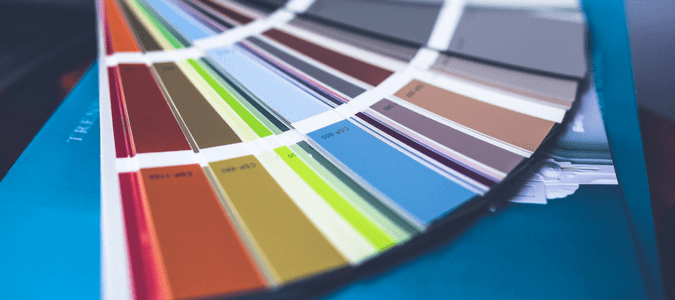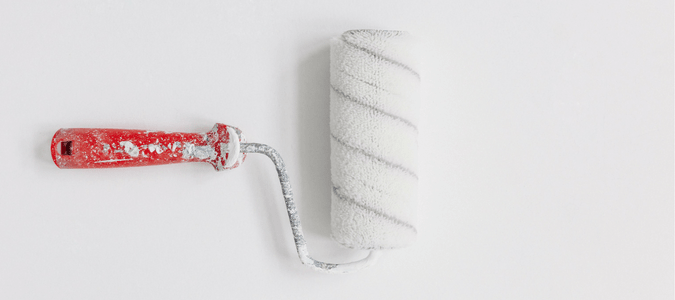
Paint is often the cheapest and easiest way to make a big change in your home. Once you have decided to paint your kitchen, bedroom, living room or bathroom, you need to determine what type of paint to use in which rooms and on which surfaces. It can be a difficult decision to make when faced with a huge selection of paint colors and types.
Let’s break down the common paint types and finishes so that you can make an educated decision about what type of paint you need for your next project.
Flat Enamel Paint
Similar to matte finish paints, flat enamel paint also has a nonreflective finish. However, flat enamel paint tends to be more durable than matte finish. Flat enamel is ideal for bathrooms, kitchens or powder rooms, since these surfaces tend to be cleaned more frequently and are exposed to more moisture.
Matte Finish
Sometimes referred to as flat finish or wall paint, matte finish has a flat or dull look to it. Matte paints are commonly used for interior walls. Since paint with a matte finish does not reflect light, this type of paint is great for hiding imperfections in the wall, such as cracks or bumps. However, surfaces covered in matte paint can be harder to clean than those with a gloss finish. A matte finish works best on ceilings and in living rooms and bedrooms where there is minimal wear and tear.
Eggshell Finish
With a very minor shine or gloss, eggshell finish holds up better than a matte or flat finish when cleaning. The ideal use for an eggshell finish is for wood such as interior paneling, living rooms, bedrooms, wallpaper and other previously painted textures.
Satin Finish
With a bit more gloss than an eggshell finish, satin finishes produce a shinier look. Commonly used for interior wood trim, hallways, ceilings and windows, paint with a satin sheen can also be used for wall paint virtually anywhere—the kitchen, the dining room and children’s bedrooms. Satin finish is designed to withstand cleaning and light washing, which makes it suitable for rooms or areas with lots of traffic.
Semi-Gloss
Semi-gloss is easy to clean and produces a subtle shine without being too bright when reflecting light. Semi-gloss is not ideal for poorly prepared walls or surfaces due to the semi-gloss producing a highlighted effect; imperfections stand out when covered in semi-gloss paint. This type of paint is ideal for doors, kitchen and bathroom cabinets.
Gloss
Gloss or high gloss paints have a shiny finish and a reflective quality with an almost plastic-like appearance. While not commonly used for home interiors, namely wall paint, gloss has been used for a dramatic effect on cabinets and trim within formal or contemporary designs. Walls with imperfections should not be painted with gloss due to its ability to illuminate them.

Oil vs. Water-Based
Another decision you will probably be faced with in your painting project is whether to choose an oil-based or a water-based paint. Oil-based paint takes a longer time to dry and can be more durable than latex. Clean-up is more of an effort, since you need to have paint thinner on hand. Some homeowners choose oil-based paint for trimwork, since these parts of your home tend to experience more wear and tear over time. Water-based (latex or acrylic) paint is most commonly used, since it’s easier to work with, colors stay vibrant for a longer period of time, there is less of an odor and this type of paint dries more quickly.
Low-VOC
Consumers can now choose from paint which contains zero or low amounts of volatile organic compounds, otherwise known as VOCs. VOCs are released into the air when paint dries. Inhaling these chemicals can cause respiratory problems, headaches and dizziness. Choosing a product with low or no VOCs does not mean you have to sacrifice performance or quality.
Primer
In most cases, homeowners will be applying paint onto a surface that has already been painted. If that is the case for your project, you’ll need to decide whether or not to use a primer. Primer helps create a more even surface for your paint to adhere to and is often less expensive than applying two coats of your average interior latex paint. A primer can also seal your painting surface and prevent your surface from absorbing excessive moisture. Lastly, a primer can cover up stains before you apply your new coat of paint.
In most cases, you do not need to apply primer to interior surfaces, unless you are painting directly onto a new wall, raw wood or drywall. Primer doesn’t adhere as well onto clean surfaces, so applying a coat of primer onto a wall that’s in good condition may be unnecessary. If the base color you are applying is similar in color to the existing paint, you don’t need the help of primer to have a better base for your new color.
Let ABC Help With Your Painting Projects
A new coat of paint can give a room an entirely new look and feel. You may think painting a few rooms in your house is high on the list of easy home improvement projects, but do you have all the right equipment, tools and know-how to get the job done? When homeowners ask what can a handyman legally do, they might not realize that can include painting and drywall repair. Leave it to the pros at ABC Home & Commercial Services to handle your painting project so that you can sit back and enjoy the final result.
